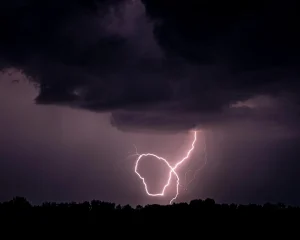
Charges form in a storm composed of ice crystals and liquid water drops. Winds inside the storm cause particles to rub against one another, causing electrons to be stripped off, making the particles either negatively or positively charged.
The charges get grouped in the cloud, often negatively charged near the bottom of the cloud and positively charged up high. This is an electric field, and because air is a good insulator, the electric fields become incredibly strong.
Eventually, the insulating capacity of the air is insufficient, and there is a rapid discharge of electricity that we know as lightning. The flash of lightning temporarily neutralizes the charged regions in the atmosphere, and the charges build up again.
The lightning causes a sudden increase in temperature in the path of a lightning bolt. Pressure change results due to the rapid expansion of the air in the path of a lightning bolt. The rapidly expanding air creates a sound wave that we hear as thunder.
Lightning can travel from cloud to cloud, within the same cloud, or between the cloud and ground. In-cloud lightning discharges are more common than cloud-to-ground discharges and are not as hazardous.
Wisconsin gets hit by lightning about 300,000 times a year, most of that during the spring and summer.
Lighting has different appearances. Staccato lightning is a cloud-to-ground lightning strike which is a short-duration stroke that often, but not always, appears as a single very bright flash and often has considerable branching.
Ribbon lightning occurs in thunderstorms with high cross winds and multiple strokes. The wind will blow each successive stroke slightly to one side of the previous stroke, causing a ribbon appearance.
Heat lightning is a common name for a lightning flash that appears to produce no discernible thunder because it occurs too far away for the thunder to be heard.
Steve Ackerman and Jonathan Martin, professors in the UW-Madison department of atmospheric and oceanic sciences, are guests on WHA radio (970 AM) at 11:45 a.m. the last Monday of each month. Send them your questions at stevea@ssec.wisc.edu or jemarti1@wisc.edu.

